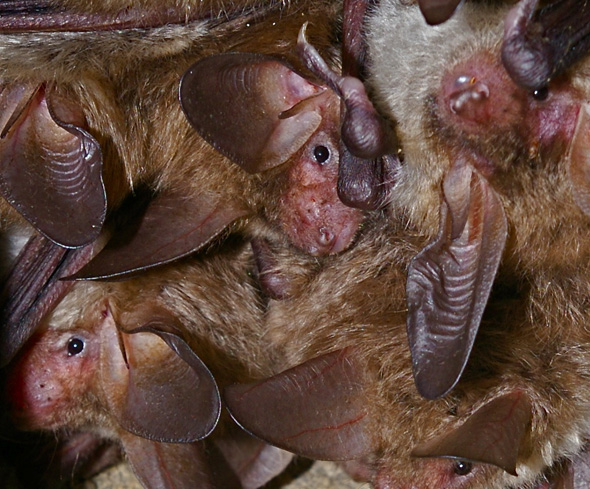August 03, 2017 | News | New publication
Bechstein’s bats don’t age
Bechstein's bat has a low death rate well into old age. This characteristic could be one reason why unusual natural events often have such severe consequences for the populations of these small mammals.

Bechstein´s bats weigh only about 10 grams, live in colonies and stop aging after their first year of life. © Gerald Kerth, University of Greifswald
A general rule that applies to almost all living creatures is that mortality, or the likelihood of dying, is not equally high at all ages. Among many mammals, mortality is high shortly after birth, then declines, and then increases again toward the end of the lifespan. This pattern does not, however, apply to Bechstein’s bats (Myotis bechsteinii). MPIDR researchers Alexander Scheuerlein and Jutta Gampe, together with biologists Toni Fleischer and Gerald Kerth of Greifswald University, have discovered that after the first year in their lives the mortality of Bechstein’s bats remains the same over the entire lifespan. In other words: they don’t grow old. The researchers have published their results in an article that appears today in the journal Scientific Reports.
“From an evolutionary point of view, every animal strives to pass on as many of its genes as possible to the next generation. There are various evolutionary adaptation strategies for achieving this goal. Smaller mammals tend to have relatively short lives, but many offspring,” Alexander Scheuerlein explained. These species accept that not all of their descendants will survive – their focus is on having large numbers of young, rather than on the survival of each individual progeny. Larger and longer-living species, such as elephants, tend to live considerably longer and to have far fewer offspring, which they then support with all of their available resources.
Bechstein’s bat, by contrast, has adopted a different evolutionary strategy. Although the bats are small (weight around 10 grams), they are long-living – the oldest individual that has been observed reached an age of 21 years; while a related species, Brandt’s bat, has been known to live 42 years or more. Bechstein’s bats have a maximum of one offspring per year, and their mortality hardly increases at all as they reach high ages. “For small mammals, this pattern is very atypical, and is closer that of sea birds or large mammals than it is to that of similarly sized mammals,” Alexander Scheuerlein said.
“Of the approximately 1,000 bat species that exist worldwide, around one-quarter are long-living. We assume that all of these long-living species have a similar aging pattern,” Alexander Scheuerlein said. He also noted, however, that these long-living species are not closely related to each other. “We can assume that longevity in bats developed independently a number of times throughout the evolutionary history of bats,” Alexander Scheuerlein said.
The researchers have several potential explanations for why bats manage to live to exceptionally high ages. One is that these long-living species primarily live in temperate zones and undergo a process of hibernation each winter in which their body temperature is sharply reduced to around 2 to 10 degrees Celsius. At these temperatures, the bat’s metabolism slows down considerably, which could lead to a reduction in molecular damage, and thus to a deceleration of the aging process.
The findings of the researchers can play an important role in efforts to protect these animals. “For the first time, we were able to show that age, size, and season have very little influence on the mortality of bats,” Gerald Kerth said. Researcher Toni Fleischer added that uncommon natural events alone were found to affect their mortality: “We have to assume that these animals are highly sensitive to unforeseen external changes.”
During the summer Bechstein’s bats live in colonies in hollow spaces of trees. During winter they hibernate in rocky crevices. In Summer the animals seek out different roosts for sleeping and raising their young almost every day. They are therefore dependent on having access to largely unmanaged forests with a lot of dead wood, as trees that have been exposed to the elements offer an adequate supply of hollow spaces for their roosts. Their colonies of around 10 to 50 animals are relatively small compared to the colonies of other bat species. “This appears to be one reason why they are so susceptible to unusual natural events,” Alexander Scheuerlein said. “Even if only a few individuals in a small colony are killed, the colony could easily become too small to produce successful offspring.”
For their study, the researchers observed 248 bats over a period of 19 years. During this time, 180 animals died, and the oldest reached 15 years of age. In the winter of 2010/2011, an extraordinarily large number of individuals died; a phenomenon that was also observed among other bat populations. Which natural events were responsible for this high death rate is as yet unknown.
Original publication:
Toni Fleischer, Jutta Gampe, Alexander Scheuerlein, Gerald Kerth: Rare catastrophic events drive population dynamics in a bat species with negligible senescence, Scientific Reports, DOI 10.1038/s41598-017-06392-9
Contact